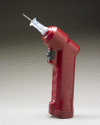Is the intraosseous access route fast and efficacious compared to conventional central venous catheterization in adult patients under resuscitation in the emergency department? A prospective observational pilot study
- PMID: 19814822
- PMCID: PMC2764565
- DOI: 10.1186/1754-9493-3-24
Is the intraosseous access route fast and efficacious compared to conventional central venous catheterization in adult patients under resuscitation in the emergency department? A prospective observational pilot study
Abstract
Background: For patients' safety reasons, current American Heart Association and European Resuscitation Council guidelines recommend intraosseous (IO) vascular access as an alternative in cases of emergency, if prompt venous catheterization is impossible. The purpose of this study was to compare the IO access as a bridging procedure versus central venous catheterization (CVC) for in-hospital adult emergency patients under resuscitation with impossible peripheral intravenous (IV) access. We hypothesised, that CVC is faster and more efficacious compared to IO access.
Methods: A prospective observational study comparing success rates and procedure times of IO access (EZ-IO, Vidacare Corporation) versus CVC in adult (>/=18 years of age) patients under trauma and medical resuscitation admitted to our emergency department with impossible peripheral IV catheterization was conducted. Procedure time was defined from preparation and insertion of vascular access type until first drug or infusion solution administration. Success rate on first attempt and procedure time for each access route was evaluated and statistically tested.
Results: Ten consecutive adult patients under resuscitation, each receiving IO access and CVC, were analyzed. IO access was performed with 10 tibial or humeral insertions, CVC in 10 internal jugular or subclavian veins. The success rate on first attempt was 90% for IO insertion versus 60% for CVC. Mean procedure time was significantly lower for IO cannulation (2.3 min +/- 0.8) compared to CVC (9.9 min +/- 3.7) (p < 0.001). As for complications, failure of IO access was observed in one patient, while two or more attempts of CVC were necessary in four patients. No other relevant complications, like infection, bleeding or pneumothorax were observed.
Conclusion: Preliminary data demonstrate that IO access is a reliable bridging method to gain vascular access for in-hospital adult emergency patients under trauma or medical resuscitation with impossible peripheral IV access. Furthermore, IO cannulation requires significantly less time to enable administration of drugs or infusion solutions compared to CVC. Because CVC was slower and less efficacious, IO access may improve the safety of adult patients under resuscitation in the emergency department.
Figures



References
-
- Costantino TG, Fojtik JP. Success rate of peripheral IV catheter insertion by emergency physicians using ultrasound guidance. Acad Emerg Med. 2003;10:487–491. doi: 10.1197/aemj.10.5.487-a. - DOI
LinkOut - more resources
Full Text Sources
Research Materials

